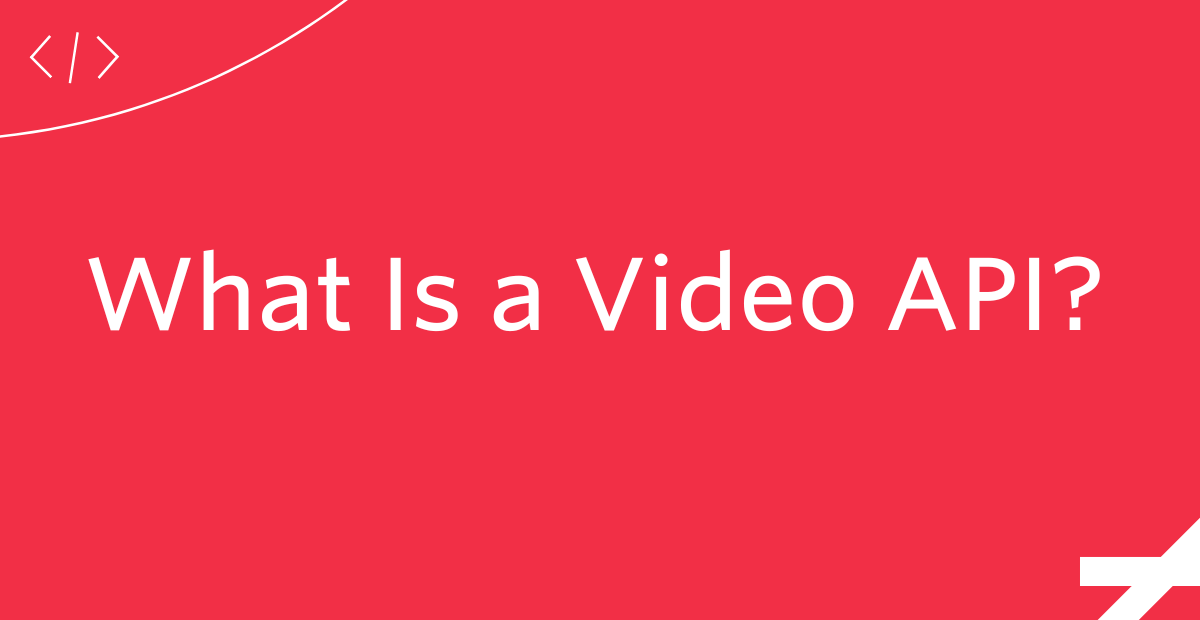What Is a Video API?
Time to read: 3 minutes

Want to add video functionality to your product, service, or application? You're going to need a video application programming interface (API).
Sure, you can find plenty of out-of-the-box video platforms and solutions out there, but these don't allow customization, flexibility, and scale like a dedicated video API.
But that’s not to say that you can buy truly innovative video applications—oh no, you have to build them. And thanks to a premium video platform, you don't have to construct it from the ground up—you can get a jump-start with an API.
Below, we'll walk you through what a video API is and how you can use it to deliver top-notch customer (and developer) experiences.
What is a video API?
A video API lets you add video functionality to your application, products, services, or website by connecting to an online video platform provider. Video APIs also empower you to add on-demand video, live streaming, real-time 1:1 meetings, group chats, and more.
For example, imagine you’re a healthcare provider who wants to host videos on your mobile application while ensuring compliance with the Health Insurance Portability and Accountability Act (HIPAA). You might want to provide:
- Exercise video libraries
- HIPAA-compliant 1:1 meetings with clients
- Employee team meetings
- Live-streaming all hands
- Webinars
- Videos with quizzes
- Virtual classrooms
Without a video API, you would need to build a complex application—requiring plenty of developers and experience. With an API, on the other hand, you could write a few lines of code and get your app up and running with video functionality in no time.
Video API use cases
Here are a few ways you can use video APIs to improve your product, service, or application:
- 1:1 video chats: Host secure GDPR-compliant meetings.
- Group video chats: Bring together 3 or more video participants.
- Video on demand: Provide videos your users can watch when they want.
- Live streaming: Live stream to your audience.
- Video playback: Add your branding and let users change the resolution, speed, and captions tailored to their preferences.
- Video analytics: Learn important audience information like playtime, rewind time stamps, viewing location, and video recommendations.
- Interactive video: Empower users to interact with quizzes, surveys, real-time chat, and more.
Benefits of a video API
So why should someone use a video API rather than building video solutions or using out-of-the-box platforms? Here are a few of the benefits of a video API:
- Customize everything: Change everything from the branding to the video playback user interface to provide the perfect experience your customers need.
- Streamline development: Use a video API that lets you tap into video functionality from the get-go without expensive developer resources and trial and error.
- Add advanced functionality: Append advanced functionality (virtual backgrounds, video recordings, and noise cancellation) to your applications in minutes instead of months with a video API.
- Integrate anywhere: Add video functionality to any website, desktop application, mobile application, or platform.
How to choose the right video API
As you can see, video APIs provide next-level customer experiences. But how do you find the right one for your needs?
Every platform and solution will have unique needs, but here are a few criteria to keep in mind as you explore your video API options:
- Affordability: Pay for exactly what you need—nothing more, nothing less.
- Video SDKs: Streamline development with software development kits.
- Documentation: Choose a platform that has extensive documentation, demos, and sample code.
- Customization: Pick a platform that empowers you to build a one-of-a-kind video experience.
- Noise cancellation: Block out background noise with high-quality audio powered by artificial intelligence technology.
- Video recording: Record your video and audio tracks for editing, mixing, and publishing later.
- Permissions: Control which meetings to record to protect user privacy.
- Video analytics: Learn how video performs within your application make data-backed changes and improvements.
- Low latency: Choose the best geolocation to support your video application.
- Uptime: Find a video API provider with a high uptime that you can trust.
- GDPR compliance: Keep your data secure and compliant with the General Data Protection Regulation.
Build a better video experience with Twilio's video API
Twilio Video empowers you to build customized video experiences for applications at scale. So whether you need a virtual platform for hiring or HIPAA-compliant 1:1 and group calls for your healthcare practice, Twilio's video API does it all.
See for yourself. Launch a 1:1 video application for free or start a free trial to build a group video calling application. Find the right starter plan on our Video pricing page.
Related Posts
Related Resources
Twilio Docs
From APIs to SDKs to sample apps
API reference documentation, SDKs, helper libraries, quickstarts, and tutorials for your language and platform.
Resource Center
The latest ebooks, industry reports, and webinars
Learn from customer engagement experts to improve your own communication.
Ahoy
Twilio's developer community hub
Best practices, code samples, and inspiration to build communications and digital engagement experiences.


